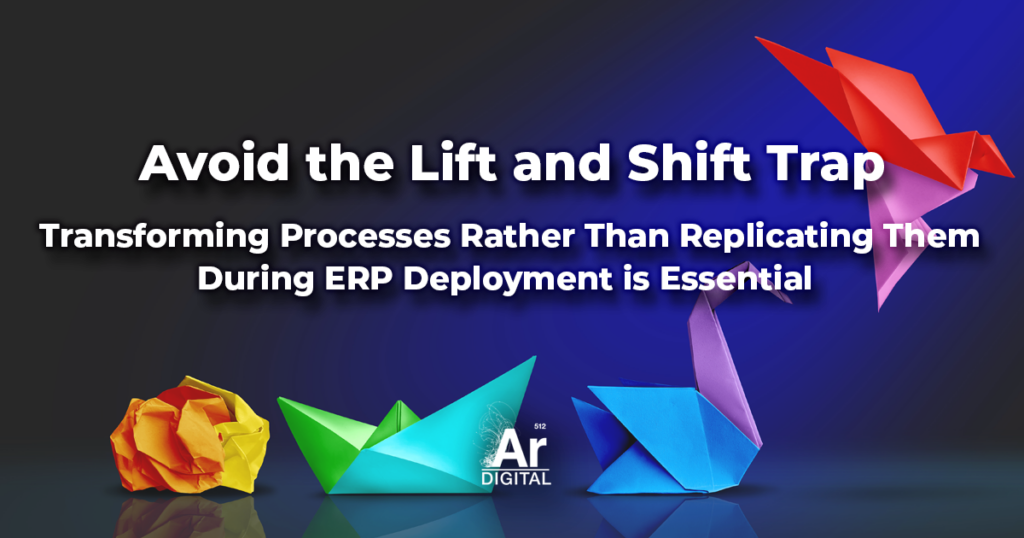Transforming Processes Rather Than Replicating Them During ERP Deployment Is Essential
Implementing a new ERP platform, like SAP, is not just about navigating technical and managerial hurdles; it’s a pivotal moment for business transformation. This process offers a unique chance to take a deep dive into your existing operations, critically evaluating whether those operations still serve your strategic objectives effectively.

What You Can Expect With A Lift and Shift
Businesses grow organically, responding to opportunities and threats in the marketplace. Decisions and actions taken in response to these factors become ingrained in the processes established to seize opportunities or mitigate threats. Over time, however, the relevance of certain threats and opportunities may diminish, yet businesses may continue to operate as if these factors are still current due to the persistence of these now outdated processes.
Many organizations miss the opportunity to transform their business by ignoring any opportunities for process changes that come with an ERP system like SAP, and instead insist on replicating current process in the new system – this is known as a ‘Lift and Shift.’
With this approach, what typically happens is the following:
1. Compare the current state processes with the ‘best of breed’ processes that are embedded in the SAP workflow.
2. Determine if the business wants to adopt the SAP workflow or keep its current state flows (assuming they differ from the SAP workflow recommendations).
3. Draft an implementation plan that comprises the following:
- Processes that will adopt the ‘out of box’ SAP solution
- Processes that will be customized in SAP.
Most companies come out of this exercise with most processes targeted for customization. This leads to long development and delivery cycles and significantly increases the likelihood of project failure or cost overruns. The reason for this is that the current state processes are considered largely immutable. The only problem for the team to solve is ‘customize or not.’
Targeting Business Value Through Elicitation
How do we keep our clients from falling into the same trap? The answer is simple and consists of just one word: Why?

By facilitating strategic elicitation, we guide our clients to answer the Why questions that ultimately tie back to one word – Value. Value can be expressed as higher revenue or lower cost or risk.
Imagine a scenario where a company has accounting processes to audit whether revenue in matches revenue earned via services sold and delivered. Perhaps there is one system that tracks the services sold, another that tracks delivery of the services, and another used to invoice clients and track the paid revenue. Because these systems are disconnected, there are manual processes to get data from one system and swivel to another system to enter the data. And because the finance team knows it’s manual and error-prone, there are additional processes to audit as a check and balance.
Some examples:
Why does this process exist?
The audit process exists because the other processes are manual, which increases the likelihood of human errors, so this audit process helps catch those errors.
Why does this specific process step exist?
In the audit process, there is a step to re-pull data into Excel to and match it up with formulas. The re-pull step is critical because it is going to the source data again, in case there was an error in the swivel pull of data from one system to another.
Why must we continue to perform this process step?
If we don’t, we might miss errors in revenue from overbilling or underbilling.
Why is this process directly related to increasing revenue or cutting cost?
If we don’t review the revenue coming against what’s expected, we might have revenue leakage. If we overbill clients, they may be upset and leave us, therefore causing revenue leakage.
Ideally, these elicitation exercises should be conducted before the discussions on process rationalization, which decide whether to utilize out-of-the-box solutions or customize workflows. However, we have seen these done very successfully as part of the rationalization conversations, so long as you have the right executives in the room.
When process owners are asked to justify their customization demands with a value response – as opposed to ‘this is how we do things’ – you will find the following happening organically:
1. Process steps are eliminated (since they are no longer justified by the initial threat or opportunity that necessitated their creation).
2. The number of customizations is reduced.
3. Customizations are less complex than originally envisioned.
4. Customizations truly reflect unique business practices that are justified due to the value they create by helping the business differentiate itself from competitors.
At ArgonDigital, our foundation rests on the core principles outlined in this article. Our commitment to delivering value informs every aspect of our work, guiding us in assisting our clients to embrace a value-driven methodology in software development for more than 20 years.



